One-Step Fabrication of Porous Membrane-Based Scaffolds by Air-Water Interfacial Phase Separation: Opportunities for Engineered Tissues
Abstract
:1. Introduction
2. Materials and Methods
2.1. Materials
2.2. Ring-Opening Polymerization of TMC and Functionalization of PTMC
2.3. Air-Water Interfacial Phase Separation for PTMC-dMA Scaffold Fabrication
2.4. Characterization of PTMC-dMA Scaffolds
2.5. Human Hepatic Stellate (LX2) Cell Culture on PTMC-dMA Scaffolds
2.6. Protein Analysis of the LX2-Conditioned Medium
2.7. Gene Analysis of Human THP-1 Monocytes Cultured in LX2-Conditioned Medium
2.8. Statistical Analysis
3. Results and Discussion
3.1. Air-Water Interfacial Phase Separation for Porous Membrane-Based Scaffold Formation
3.2. Essential Parameters for One-Step PTMC-dMA Porous Scaffold Fabrication on the Air-Water Interface
3.2.1. PTMC-dMA Concentration Determines Homogeneity of the Porous Scaffolds
3.2.2. Solvents Influence Pore Morphology and Scaffold Thickness
3.2.3. Temperature Affects PTMC-dMA Spreading on Water
3.3. Scaffold Porosity and Pore Size Can Be Controlled without the Addition of Porogens
3.4. Mechanical Properties
3.5. Pore Structure of PTMC-dMA Membrane-Based Scaffolds
3.6. Porous PTMC-dMA Membrane-Based Scaffolds for Liver Tissue Engineering
3.6.1. Porous PTMC-dMA Membrane-Based Scaffolds Are Biocompatible
3.6.2. Porous PTMC-dMA Membrane-Based Scaffolds Do Not Induce Inflammatory Response
3.6.3. Porous PTMC-dMA Membrane-Based Scaffolds Induce Extracellular Matrix Formation by Human Stellate Cells
4. Conclusions and Outlook
Supplementary Materials
Author Contributions
Funding
Data Availability Statement
Acknowledgments
Conflicts of Interest
References
- Warkiani, M.E.; Bhagat, A.A.S.; Khoo, B.L.; Han, J.; Lim, C.T.; Gong, H.Q.; Fane, A.G. Isoporous micro/nanoengineered membranes. ACS Nano 2013, 7, 1882–1904. [Google Scholar] [CrossRef] [PubMed]
- van Bochove, B.; Grijpma, D.W. Mechanical properties of porous photo-crosslinked poly(trimethylene carbonate) network films. Eur. Polym. J. 2021, 143, 110223. [Google Scholar] [CrossRef]
- Williams, J.M.; Adewunmi, A.; Schek, R.M.; Flanagan, C.L.; Krebsbach, P.H.; Feinberg, S.E.; Hollister, S.J.; Das, S. Bone tissue engineering using polycaprolactone scaffolds fabricated via selective laser sintering. Biomaterials 2005, 26, 4817–4827. [Google Scholar] [CrossRef] [PubMed]
- Remanan, S.; Sharma, M.; Bose, S.; Das, N.C. Recent Advances in Preparation of Porous Polymeric Membranes by Unique Techniques and Mitigation of Fouling through Surface Modification. ChemistrySelect 2018, 3, 609–633. [Google Scholar] [CrossRef]
- Ismail, H.M.; Zamani, S.; Elrayess, M.A.; Kafienah, W.; Younes, H.M. New three-dimensional poly(decanediol-co-tricarballylate) elastomeric fibrous mesh fabricated by photoreactive electrospinning for cardiac tissue engineering applications. Polymers 2018, 10, 455. [Google Scholar] [CrossRef] [Green Version]
- Guo, Z.; Grijpma, D.W.; Poot, A.A. Preparation and characterization of flexible and elastic porous tubular PTMC scaffolds for vascular tissue engineering. Polym. Adv. Technol. 2017, 28, 1239–1244. [Google Scholar] [CrossRef]
- Santos-Rosales, V.; Iglesias-Mejuto, A.; García-González, C.A. Solvent-free approaches for the processing of scaffolds in regenerative medicine. Polymers 2020, 12, 533. [Google Scholar] [CrossRef] [Green Version]
- Guillaume, O.; Geven, M.A.; Varjas, V.; Varga, P.; Gehweiler, D.; Stadelmann, V.A.; Smidt, T.; Zeiter, S.; Sprecher, C.; Bos, R.R.M.; et al. Orbital floor repair using patient specific osteoinductive implant made by stereolithography. Biomaterials 2020, 233, 119721. [Google Scholar] [CrossRef]
- Pasman, T.; Baptista, D.; van Riet, S.; Truckenmüller, R.K.; Hiemstra, P.S.; Rottier, R.J.; Stamatialis, D.; Poot, A.A. Development of porous and flexible ptmc membranes for in vitro organ models fabricated by evaporation-induced phase separation. Membranes 2020, 10, 330. [Google Scholar] [CrossRef]
- Brougham, C.M.; Levingstone, T.J.; Shen, N.; Cooney, G.M.; Jockenhoevel, S.; Flanagan, T.C.; O’Brien, F.J. Freeze-Drying as a Novel Biofabrication Method for Achieving a Controlled Microarchitecture within Large, Complex Natural Biomaterial Scaffolds. Adv. Healthc. Mater. 2017, 6, 1700598. [Google Scholar] [CrossRef]
- Drozdov, A.D.; de Claville Christiansen, J. The effect of porosity on elastic moduli of polymer foams. J. Appl. Polym. Sci. 2019, 137, 48450. [Google Scholar] [CrossRef]
- Guo, Z.; Grijpma, D.; Poot, A. Leachable poly(trimethylene carbonate)/CaCO3 composites for additive manufacturing of microporous vascular structures. Materials 2020, 13, 3435. [Google Scholar] [CrossRef] [PubMed]
- Zhang, Z.; Kuijer, R.; Bulstra, S.K.; Grijpma, D.W.; Feijen, J. The in vivo and in vitro degradation behavior of poly(trimethylene carbonate). Biomaterials 2006, 27, 1741–1748. [Google Scholar] [CrossRef] [PubMed]
- Allijn, I.; Ribeiro, M.; Poot, A.; Passier, R.; Stamatialis, D. Membranes for modelling cardiac tissue stiffness in vitro based on poly(Trimethylene carbonate) and poly(ethylene glycol) polymers. Membranes 2020, 10, 274. [Google Scholar] [CrossRef]
- Zant, E.; Blokzijl, M.M.; Grijpma, D.W. A Combinatorial Photocrosslinking Method for the Preparation of Porous Structures with Widely Differing Properties. Macromol. Rapid Commun. 2015, 36, 1902–1909. [Google Scholar] [CrossRef]
- Geremia, I.; Pavlenko, D.; Maksymow, K.; Rüth, M.; Lemke, H.D.; Stamatialis, D. Ex vivo evaluation of the blood compatibility of mixed matrix haemodialysis membranes. Acta Biomater. 2020, 111, 118–128. [Google Scholar] [CrossRef]
- Noh, J.; Jeong, S.; Lee, J.Y. Ultrafast formation of air-processable and high-quality polymer films on an aqueous substrate. Nat. Commun. 2016, 7, 12374. [Google Scholar] [CrossRef]
- Ward, W.J.; Browall, W.R.; Salemme, R.M. Ultrathin silicone/polycarbonate membranes for gas separation processes. J. Membr. Sci. 1976, 1, 99–108. [Google Scholar] [CrossRef]
- Frysinger, G.S.; Barnoski, A.A.; Gaines, G.L.; Korenowski, G.M. Molecular Arrangement of a Poly(acrylonitrile-co-4-vinylpyridine) Monolayer on Water. Langmuir 1994, 10, 2277–2280. [Google Scholar] [CrossRef]
- Liu, L.; Chakma, A.; Feng, X. A novel method of preparing ultrathin poly(ether block amide) membranes. J. Membr. Sci. 2004, 235, 43–52. [Google Scholar] [CrossRef]
- Bormashenko, E.; Chaniel, G.; Gendelman, O. Hydrophilization and hydrophobic recovery in polymers obtained by casting of polymer solutions on water surface. J. Colloid Interface Sci. 2014, 435, 192–197. [Google Scholar] [CrossRef] [PubMed]
- Pandey, M.; Pandey, S.S.; Nagamatsu, S.; Hayase, S.; Takashima, W. Controlling factors for orientation of conjugated polymer films in dynamic floating-film transfer method. J. Nanosci. Nanotechnol. 2017, 17, 1915–1922. [Google Scholar] [CrossRef]
- Colberts, F.J.M.; Wienk, M.M.; Heuvel, R.; Li, W.; Le Corre, V.M.; Koster, L.J.A.; Janssen, R.A.J. Bilayer–Ternary Polymer Solar Cells Fabricated Using Spontaneous Spreading on Water. Adv. Energy Mater. 2018, 8, 1802197. [Google Scholar] [CrossRef]
- Kim, D.; Kim, S.H.; Park, J.Y. Floating-on-water fabrication method for thin polydimethylsiloxane membranes. Polymers 2019, 11, 1264. [Google Scholar] [CrossRef] [PubMed] [Green Version]
- Roy, P.K.; Shoval, S.; Dombrovsky, L.A.; Bormashenko, E. Oscillatory reversible osmotic growth of sessile saline droplets on a floating polydimethylsiloxane membrane. Fluids 2021, 6, 232. [Google Scholar] [CrossRef]
- Li, S.; Chung, H.S.; Simakova, A.; Wang, Z.; Park, S.; Fu, L.; Cohen-Karni, D.; Averick, S.; Matyjaszewski, K. Biocompatible Polymeric Analogues of DMSO Prepared by Atom Transfer Radical Polymerization. Biomacromolecules 2017, 18, 475–482. [Google Scholar] [CrossRef]
- van Bochove, B.; Grijpma, D.W. Photo-Crosslinked Synthetic Biodegradable Polymer Networks for Biomedical Applications. J. Biomater. Sci. Polym. Ed. 2018, 30, 77–106. [Google Scholar] [CrossRef] [Green Version]
- Ginzberg, M.B.; Kafri, R.; Kirschner, M. On being the right (cell) size. Science 2015, 348, 1245075. [Google Scholar] [CrossRef] [Green Version]
- Saremi, F.; Sánchez-Quintana, D.; Mori, S.; Muresian, H.; Spicer, D.E.; Hassani, C.; Anderson, R.H. Fibrous Skeleton of the Heart: Anatomic Overview and Evaluation of Pathologic Conditions with CT and MR Imaging. Radiographics 2017, 37, 1330–1351. [Google Scholar] [CrossRef]
- Orlando, G.; Booth, C.; Wang, Z.; Totonelli, G.; Ross, C.L.; Moran, E.; Salvatori, M.; Maghsoudlou, P.; Turmaine, M.; Delario, G.; et al. Discarded human kidneys as a source of ECM scaffold for kidney regeneration technologies. Biomaterials 2013, 34, 5915–5925. [Google Scholar] [CrossRef]
- Ohtani, O.; Ohtani, Y. Lymph circulation in the liver. Anat. Rec. 2008, 291, 643–652. [Google Scholar] [CrossRef] [PubMed]
- Hussein, K.H.; Park, K.M.; Yu, L.; Kwak, H.H.; Woo, H.M. Decellularized hepatic extracellular matrix hydrogel attenuates hepatic stellate cell activation and liver fibrosis. Mater. Sci. Eng. C 2020, 116, 111160. [Google Scholar] [CrossRef] [PubMed]
- Zant, E.; Grijpma, D.W. Synthetic Biodegradable Hydrogels with Excellent Mechanical Properties and Good Cell Adhesion Characteristics Obtained by the Combinatorial Synthesis of Photo-Cross-Linked Networks. Biomacromolecules 2016, 17, 1582–1592. [Google Scholar] [CrossRef] [PubMed]
- Papenburg, B.J.; Schüller-Ravoo, S.; Bolhuis-Versteeg, L.A.M.; Hartsuiker, L.; Grijpma, D.W.; Feijen, J.; Wessling, M.; Stamatialis, D. Designing porosity and topography of poly(1,3-trimethylene carbonate) scaffolds. Acta Biomater. 2009, 5, 3281–3294. [Google Scholar] [CrossRef]
- Cui, J.; Wang, H.; Shi, Q.; Sun, T.; Huang, Q.; Fukuda, T. Multicellular co-culture in three-dimensional gelatin methacryloyl hydrogels for liver tissue engineering. Molecules 2019, 24, 1762. [Google Scholar] [CrossRef] [Green Version]
- Allijn, I.E.; Vaessen, S.F.C.; Quarles van Ufford, L.C.; Beukelman, K.J.; de Winther, M.P.J.; Storm, G.; Schiffelers, R.M. Head-to-Head Comparison of Anti-Inflammatory Performance of Known Natural Products In Vitro. PLoS ONE 2016, 11, e0155325. [Google Scholar] [CrossRef] [Green Version]
- Donaldson, A.R.; Tanase, C.E.; Awuah, D.; Bathrinarayanan, P.V.; Hall, L.; Nikkhah, M.; Khademhosseini, A.; Rose, F.; Alexander, C.; Ghaemmaghami, A.M. Photocrosslinkable gelatin hydrogels modulate the production of the major pro-inflammatory cytokine, TNF-α, by human mononuclear cells. Front. Bioeng. Biotechnol. 2018, 6, 116. [Google Scholar] [CrossRef]
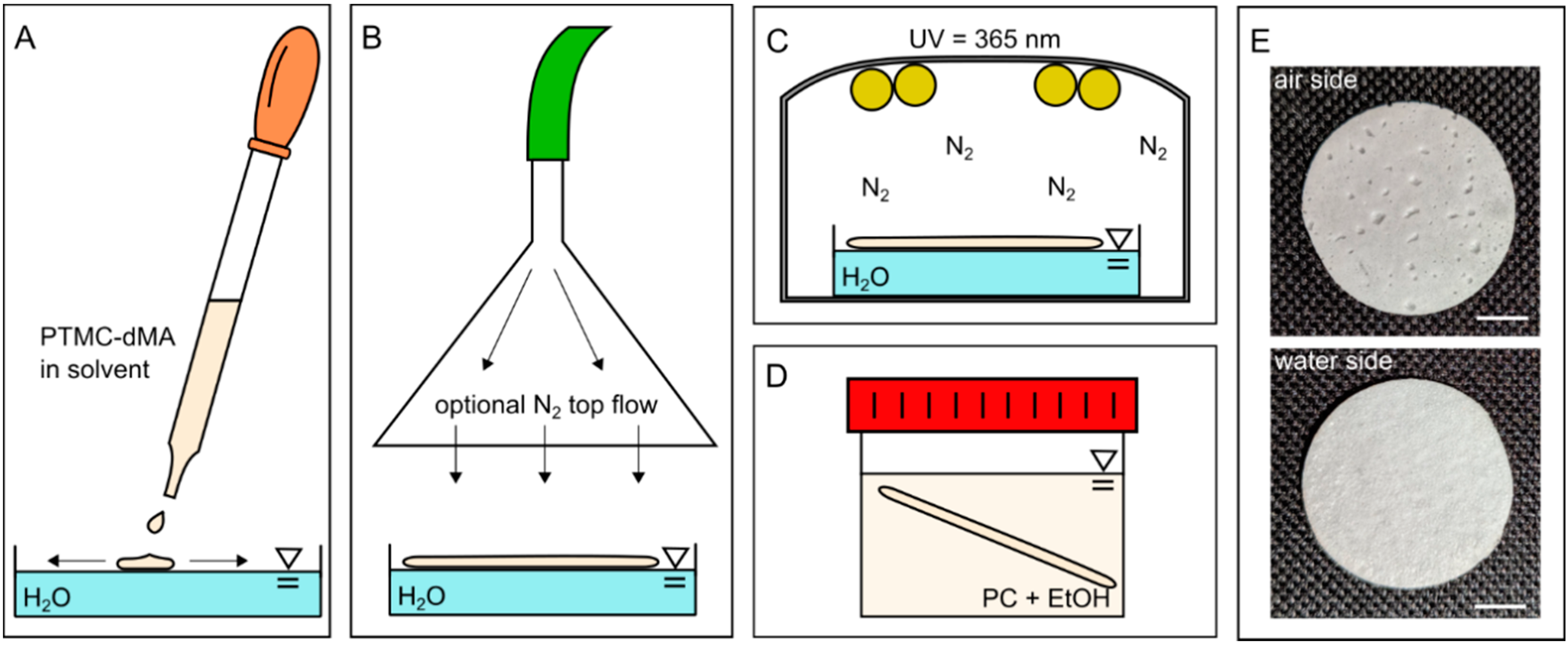
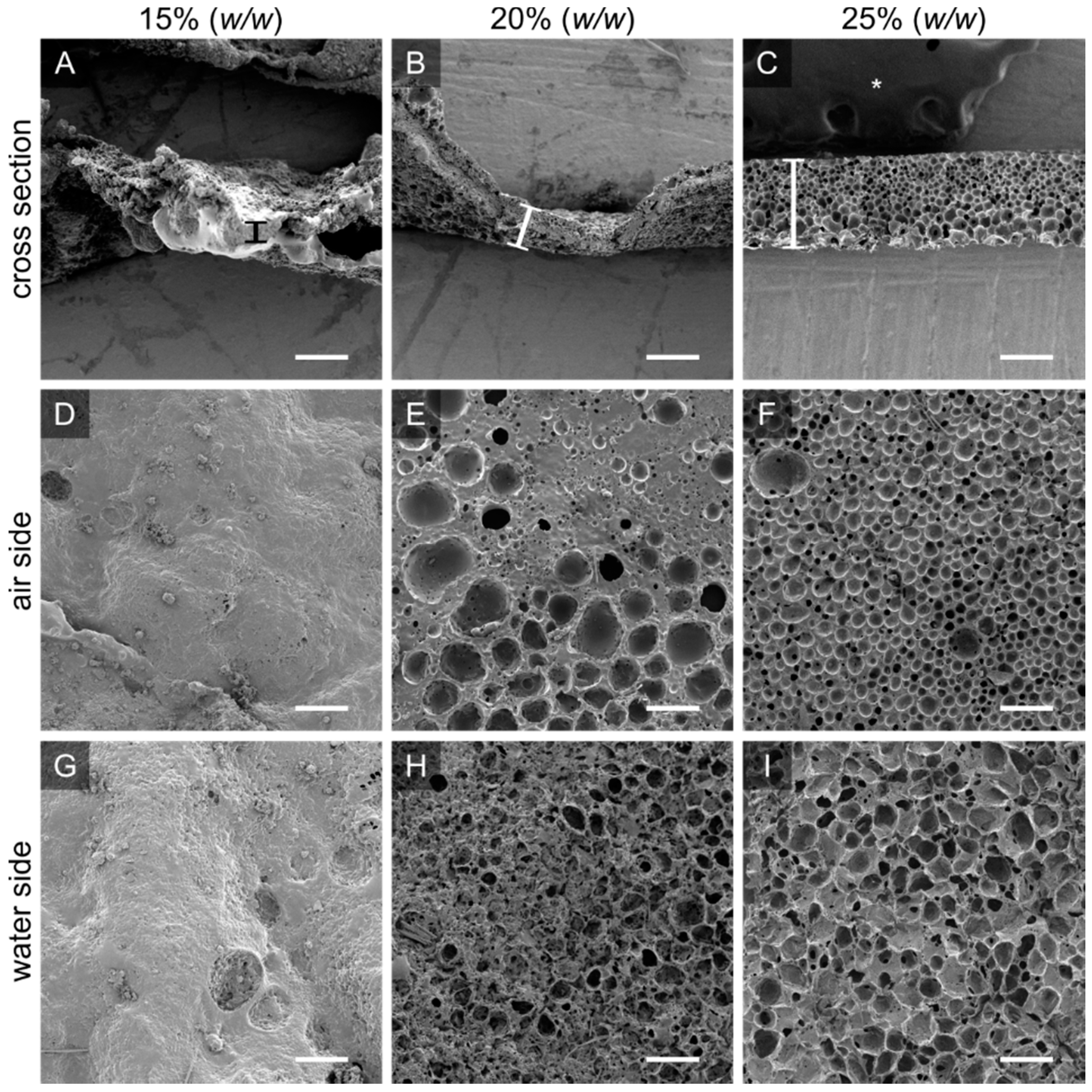
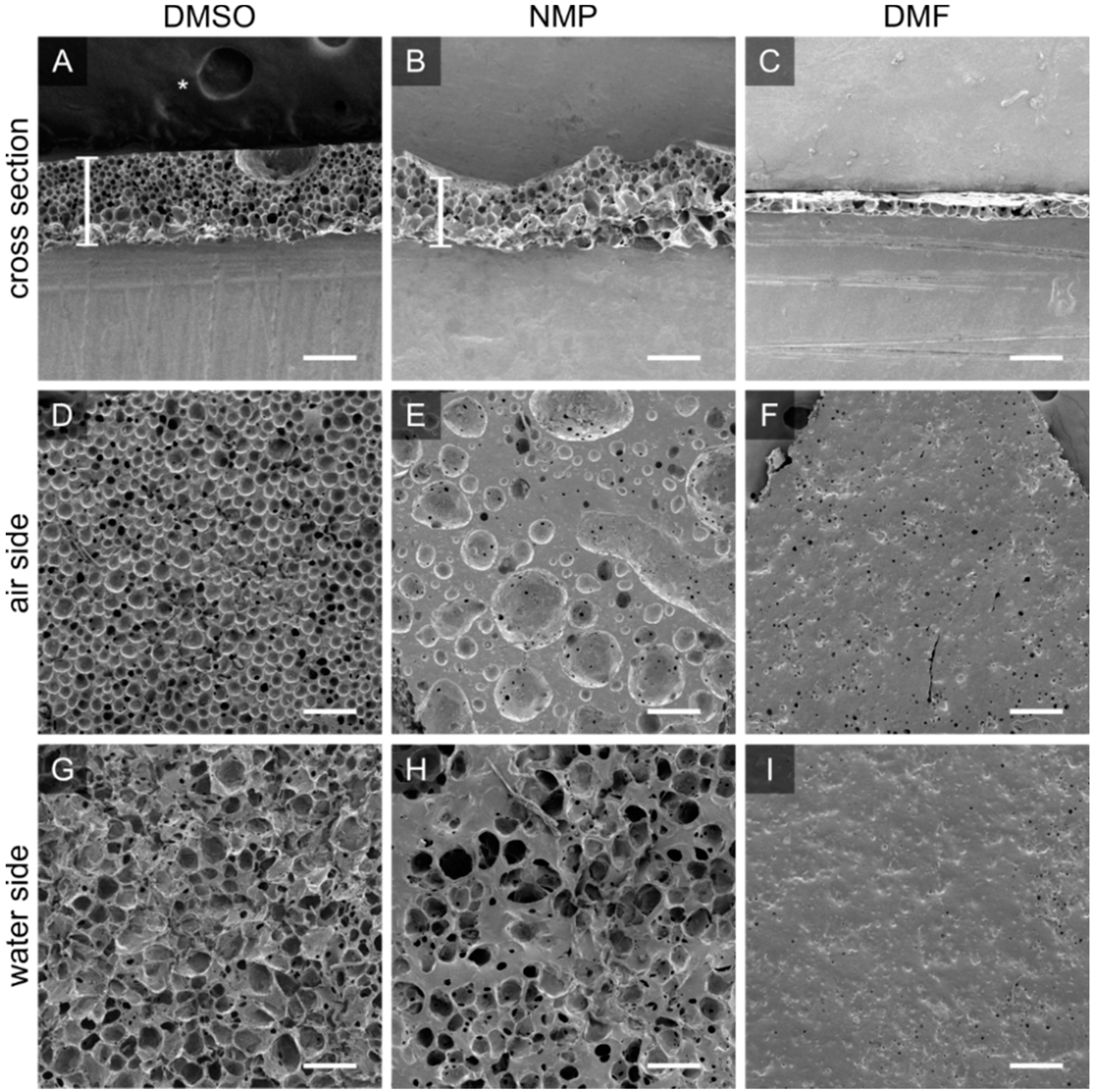
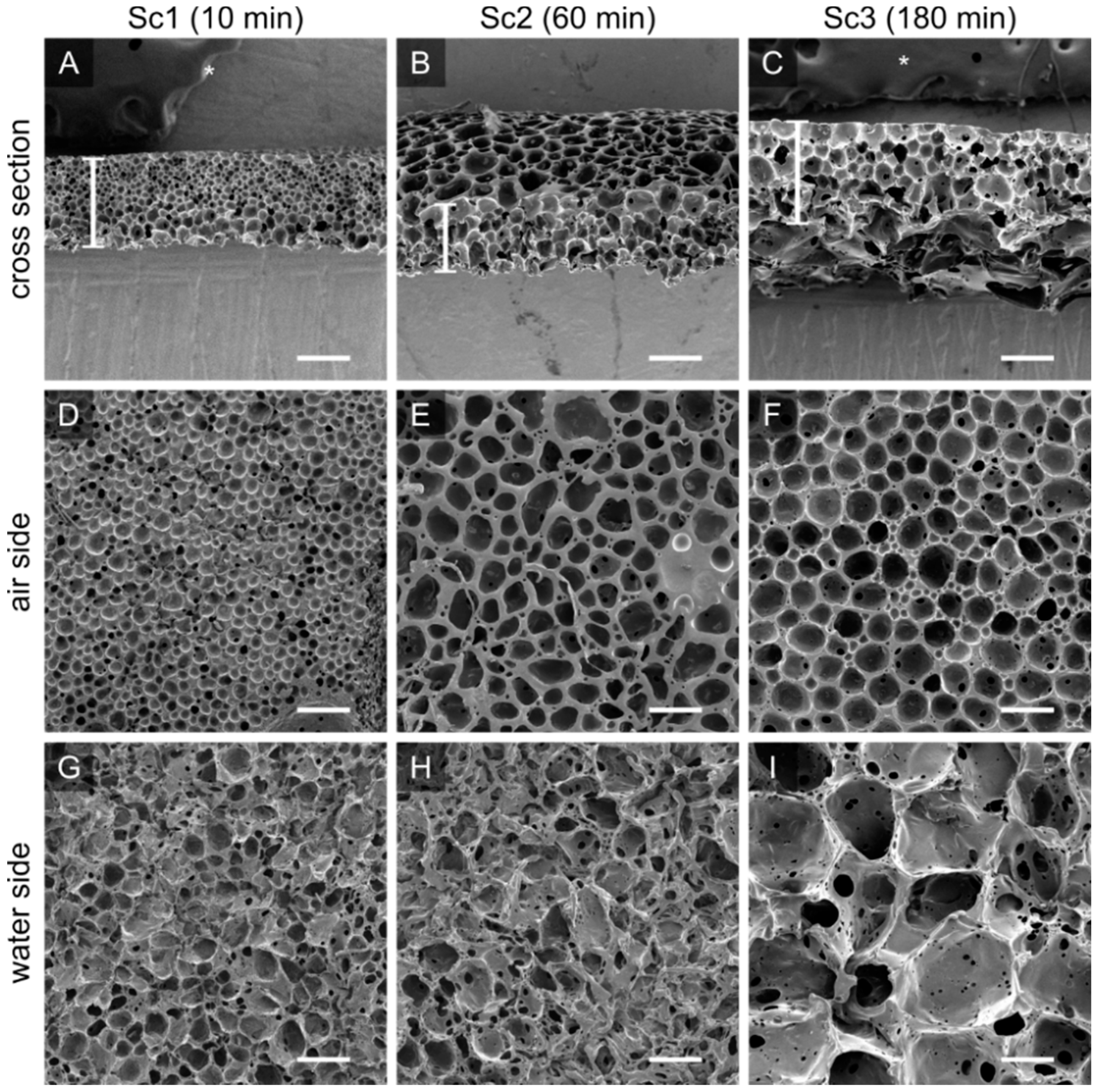
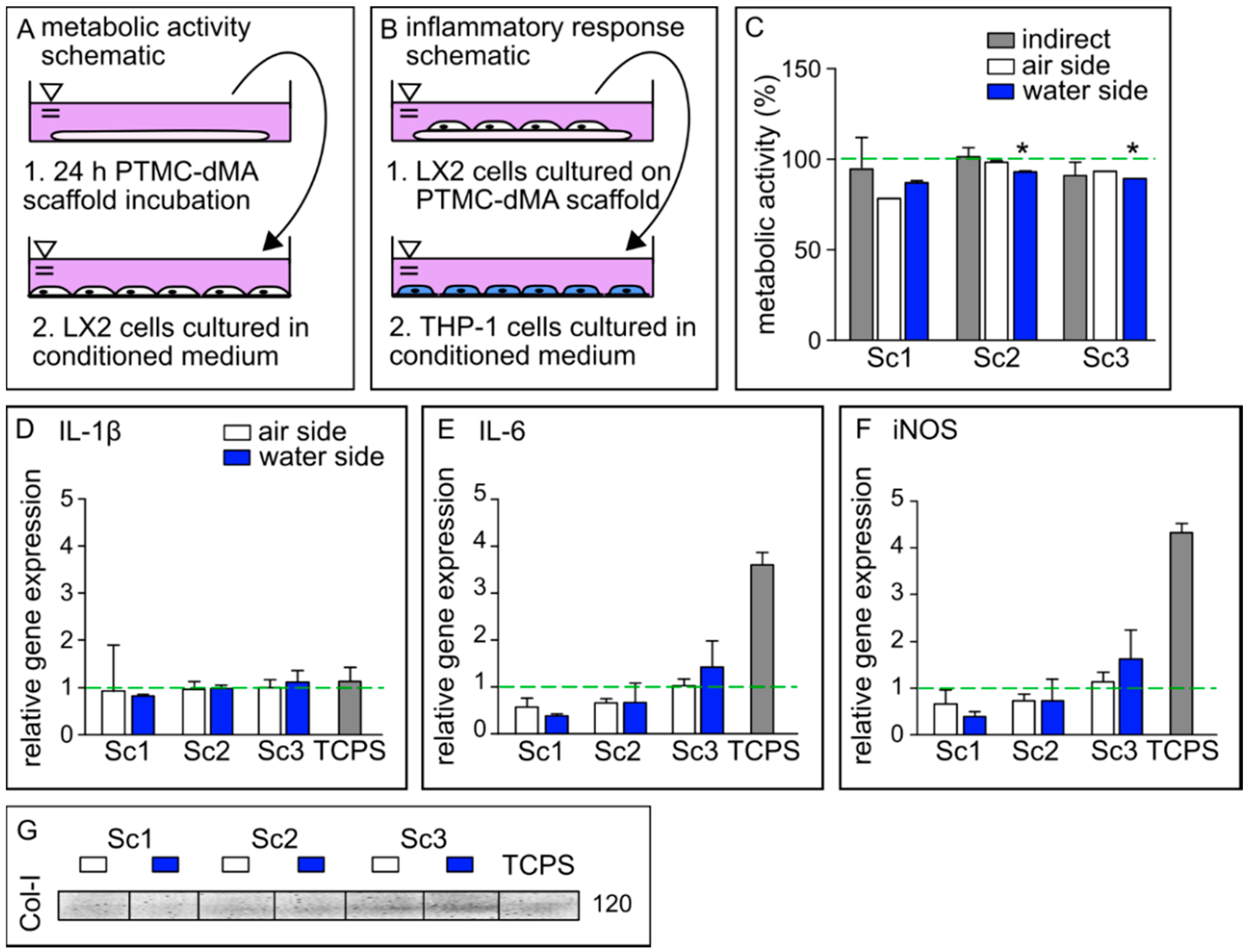
| Non-Solvents | Solvents | ||||||
|---|---|---|---|---|---|---|---|
| Water | EtOH | DMSO | NMP | DMF | PC | CHCl3 | |
| CAS RN | 7732-18-5 | 64-17-5 | 67-68-5 | 872-50-4 | 68-12-2 | 108-32-7 | 67-663 |
| MW (g/mol) | 18.02 | 46.069 | 78.13 | 99.13 | 73.1 | 102.9 | 119.37 |
| Hildebrand factor (δ SI) | 48 | 26.2 | 29.7 | 23.1 | 24.7 | 27.2 | 18.7 |
| Water solubility (%) | 100 | 100 | 100 | 100 | 100 | 8.3 | 0.82 |
| Polarity index | 10.2 | 5.2 | 7.2 | 6.7 | 6.4 | 6.1 | 4.1 |
| Freezing point (°C) | 0 | −114.1 | 18.5 | −24.4 | −60.4 | −55.0 | −63.55 |
| Boiling point (°C) | 100 | 78.32 | 189 | 202 | 153 | 242 | 61.15 |
| Surface tension (mN/m) | 74.9 (5 °C) 72.8 (20 °C) 66.2 (60 °C) | 22.4 (20 °C) | 43.5 (20 °C) | 40.8 (20 °C) | 36.8 (20 °C) | 41.9 (20 °C) | 27.1 (20 °C) |
| Scaffold Characteristic | PTMC-dMA 1 | Sc1 (10 min) | Sc2 (60 min) | Sc3 (180 min) | Significance |
|---|---|---|---|---|---|
| Gel content (%) | 93 ± 5 | 91 ± 5 | 86 ± 3 | ns | |
| Porosity (%) | - | 70 ± 1 | 75 ± 3 | 81 ± 2 | Sc1-Sc2 **, Sc1-Sc3 ***, Sc2-Sc3 ** |
| Pores/0.86 mm2—air side | - | 784 | 129 | 111 | - |
| Pore diameter—air side (µm) | - | 21 ± 18 | 44 ± 3 | 52 ± 4 | Sc1-Sc2, Sc3 ***, Sc2-Sc3 * |
| Pores/0.86 mm2–water side | - | 75 | 32 | 5 | - |
| Pore diameter–water side (µm) | - | 74 ± 32 | 98 ± 58 | 295 ± 50 | Sc1-Sc2 *, Sc1-Sc3 ***, Sc2-Sc3 *** |
| Permeance (L/m2 × h × bar) | - | 3 ± 3 | 249 ± 3 | 267 ± 53 | Sc1-Sc2 **, Sc1-Sc3 *** |
| Young’s modulus (kPa) | 2531 ± 338 | 575 ± 40 | 617 ± 55 | 544 ± 54 | ns |
| dL at break (%) | 1969 ± 619 | 122 ± 31 | 123 ± 35 | 83 ± 49 | ns |
| Max. stress (kPa) | 2312 ± 820 | 399 ± 61 | 487 ± 40 | 275 ± 109 | ns |
| Toughness (N/mm2) | 2194 ± 1036 | 4 ± 2 | 4 ± 3 | 15 ± 12 | ns |
Publisher’s Note: MDPI stays neutral with regard to jurisdictional claims in published maps and institutional affiliations. |
© 2022 by the authors. Licensee MDPI, Basel, Switzerland. This article is an open access article distributed under the terms and conditions of the Creative Commons Attribution (CC BY) license (https://creativecommons.org/licenses/by/4.0/).
Share and Cite
Allijn, I.; du Preez, N.; Tasior, M.; Bansal, R.; Stamatialis, D. One-Step Fabrication of Porous Membrane-Based Scaffolds by Air-Water Interfacial Phase Separation: Opportunities for Engineered Tissues. Membranes 2022, 12, 453. https://doi.org/10.3390/membranes12050453
Allijn I, du Preez N, Tasior M, Bansal R, Stamatialis D. One-Step Fabrication of Porous Membrane-Based Scaffolds by Air-Water Interfacial Phase Separation: Opportunities for Engineered Tissues. Membranes. 2022; 12(5):453. https://doi.org/10.3390/membranes12050453
Chicago/Turabian StyleAllijn, Iris, Nikola du Preez, Małgorzata Tasior, Ruchi Bansal, and Dimitrios Stamatialis. 2022. "One-Step Fabrication of Porous Membrane-Based Scaffolds by Air-Water Interfacial Phase Separation: Opportunities for Engineered Tissues" Membranes 12, no. 5: 453. https://doi.org/10.3390/membranes12050453
APA StyleAllijn, I., du Preez, N., Tasior, M., Bansal, R., & Stamatialis, D. (2022). One-Step Fabrication of Porous Membrane-Based Scaffolds by Air-Water Interfacial Phase Separation: Opportunities for Engineered Tissues. Membranes, 12(5), 453. https://doi.org/10.3390/membranes12050453







